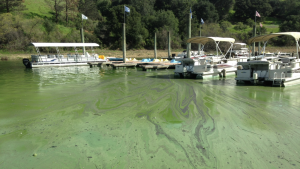Blue-Green Algae Information
Blue-Green Algae (also called cyanobacteria) are natural organisms that are present around the world in ocean and fresh water. Certain conditions – low water levels, limited water circulation, increased temperature and light, among other factors – can cause blue-green algae to bloom and, in some cases, release toxins. Scientists do not know what causes the blue-green algae to become toxic. We do know that these blooms are increasing around the world.
In 2014, the Park District had its first ever toxic algae bloom. Three incidents of toxic blooms were documented that year, most likely due to the drought. Two toxic blooms occurred in Lake Temescal in Oakland. Both blooms resulted in lake closures to swimming for a total of about nine weeks over the summer and fall. Another bloom was observed in Lake Chabot. Since 2014, the Park District has created a robust Harmful Algal Bloom (HAB) monitoring program to help ensure safe recreation in our lakes. To date, blue-green algae blooms and toxins have been observed at all major Park District water bodies.
The most common blue-green algae toxins are Anatoxin-A, which impacts the nervous system, and Microcystin, which affects the liver. Exposure to toxic algae, either through ingestion or skin contact, can cause rashes, skin and eye irritation, allergic reactions, gastrointestinal problems or, at high doses, serious illness or death, according to the California Department of Public Health. In the past few years, several dog deaths in California have been attributed to toxic algae poisoning. To ensure fish are safe to eat throughout the Park District, annual fish tissue toxin tests are performed at major Park District lakes. Additionally, the new and improved Del Valle drinking water plant is tested regularly to ensure algal blooms do not impact drinking water sourced from the reservoir. For more information on blue-green algae please refer to the CCHABS website.
As the effects of climate change continue to escalate, we expect to see increased duration and frequency of harmful algal blooms. The Park District is implementing a diverse suite of management strategies to try and reduce the blooms and remediate the conditions causing the blooms. In July 2020, a hypolimnetic oxygenation system (HOS) was installed at Lake Anza in Tilden Regional Park. The goal of this system is to reduce the frequency and duration of toxic blooms by adding oxygen to the depths of Lake Anza. Oxygen binds essential nutrients making them unavailable for blue-green algae growth. At Lake Temescal, application of a bonding agent have been used to limit and control HABs.
Current Water Quality Conditions
Due to the drought and unusually warm weather conditions, toxic blooms of cyanobacteria (blue-green algae) and other water-quality issues are occurring more frequently in the East Bay Regional Park District and elsewhere. We monitor our lakes and shorelines regularly and post warnings and closures when appropriate. Here’s a current update of which lakes and shorelines are affected:






